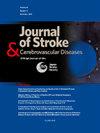Outcomes of carotid endarterectomy in symptomatic octogenarian patients
IF 1.8
4区 医学
Q3 NEUROSCIENCES
Journal of Stroke & Cerebrovascular Diseases
Pub Date : 2025-06-10
DOI:10.1016/j.jstrokecerebrovasdis.2025.108375
引用次数: 0
Abstract
Introduction
Carotid endarterectomy (CEA) is the standard treatment for symptomatic carotid artery stenosis (ipsilateral cerebral ischemic symptoms in the last 3months - SCS) in patients suitable for open surgery. Given the increasing age of the general population, this treatment is performed in octogenarian patients with increasing frequency. However, this population was not included in the historical randomized controlled trials and there is a lack of available data on perioperative complications, specifically the severity of possible postoperative stroke. The aim of this study is to report the outcomes of CEA for SCS in octogenarians and to evaluate the characteristics of postoperative stroke, in comparison to non-octogenarians.
Methods
This is a retrospective analysis of patients treated with CEA from 2012 to 2023 for SCS. Patients were divided according to their age in non-octogenarian (<80year-old) and octogenarian (≥80 year-old) and compared according to type of preoperative symptoms and timing of intervention. The primary endpoints of this study were to analyze the postoperative stroke and death rate and to assess the severity of postoperative stroke in octogenarian and non-octogenarian patients using the National Institute of Health Institute of Stroke Scale (NIHSS) classification. Follow-up was performed with yearly clinical visit.
Results
A total of 664 symptomatic patients were treated by CEA, 157(24 %) were octogenarian (mean age 84 ± 4) and had similar preoperative characteristics of non-octogenarian except for the distribution of preoperative neurological type of symptoms: transient ischemic attack (TIA) 51 %vs42 %,P = .05, amaurosis fugax (AF) 14 %vs5 %,P = .001; stroke 36 %vs53 %,P = .01. The timing between symptoms and surgery was similar between the octogenarian and non-octogenarian patients 10 ± 8vs8 ± 7 days(P = .22). The overall postoperative rate of stroke and death was 3.1 %, similar between octogenarian and non-octogenarian: 3.7 %vs.3.1 %,P = .39. The type of preoperative symptoms did not affect the outcome between older and younger patients: TIA 3.4 %vs.3.3 %,P = .63; AF 0 %vs0 %,P = .1.0 and stroke 3.5 %vs.3.3 %,P = 1.0. In octogenarian patients stroke and death rate was similar independently on the timing of CEA performance: 3.9 %, if performed within 48h, 3.7 % between 2days and 14 days and 3.4 % after 2 weeks, P = .72. Postoperative stroke rate was similar in the two groups: 15(2.9 %) in non-octogenarians and 5(3 %) in octogenarian patients (P = .1); but moderate/severe stroke (NIHSS ≥ 5) was more frequent in octogenarian patients: 2 % vs 0.4 %, P = .05 The mean follow-up was 68±14 months and at 5-year the ipsilateral stroke free survival was 97.6 % ± 4 % with no differences between octogenarian and non-octogenarian: 95.2 % ± 6 %vs98.1 % ± 3 %,P = .32.
Conclusion
SCS octogenarian submitted to CEA have a low rate of perioperative and follow-up events, comparable with non-octogenarian. The timing and the type of symptoms do not seem to affect the CEA outcome. However, when a postoperative stroke occurs in the older patients, its severity is greater.
有症状的八十多岁患者颈动脉内膜切除术的结果
颈动脉内膜切除术(CEA)是适合开放手术患者的症状性颈动脉狭窄(近3个月同侧脑缺血症状- SCS)的标准治疗方法。鉴于一般人群年龄的增加,这种治疗在80多岁患者中进行的频率越来越高。然而,该人群并未纳入历史随机对照试验,并且缺乏围手术期并发症的可用数据,特别是可能的术后卒中的严重程度。本研究的目的是报道CEA在80岁老人中治疗SCS的结果,并与非80岁老人进行比较,评估术后卒中的特征。方法回顾性分析2012年至2023年接受CEA治疗的SCS患者。将患者按年龄分为非80岁(≥80岁)和80岁(≥80岁),并根据术前症状类型和干预时间进行比较。本研究的主要终点是使用美国国立卫生研究院卒中量表(NIHSS)分类分析80多岁和非80多岁患者的术后卒中和死亡率,并评估术后卒中的严重程度。随访时每年进行一次临床访问。结果经CEA治疗的有症状患者664例,其中高龄患者157例(24%),平均年龄84±4岁,除术前神经症状类型分布外,与非高龄患者具有相似的术前特征:短暂性脑缺血发作(TIA) 51% vs 42%,P = 0.05;卒中36% vs 53%,P = 0.01。80岁和非80岁患者的症状和手术时间间隔相似(10±8vs8±7天)(P = 0.22)。术后卒中和死亡的总发生率为3.1%,80多岁和非80多岁患者相似:3.7% vs. 3.1%,P = 0.39。术前症状类型不影响老年和年轻患者的预后:TIA 3.4% vs. 3.3%,P = 0.63;房颤0% vs. 0%,P = 1.0;卒中3.5% vs. 3.3%,P = 1.0。在80多岁的患者中,脑卒中和死亡率独立于CEA表现的时间相似:如果在48小时内进行,则为3.9%,2天至14天为3.7%,2周后为3.4%,P = 0.72。两组患者术后卒中发生率相似:非80岁患者15例(2.9%),80岁患者5例(3%)(P = 0.1);但中重度脑卒中(NIHSS≥5)在80多岁患者中更为常见:2% vs 0.4%,P = 0.05,平均随访时间为68±14个月,5年同侧脑卒中无生存率为97.6%±4%,80多岁与非80多岁患者无差异:95.2%±6% vs 98.1%±3%,P = 0.32。结论经CEA治疗的scs高龄患者围手术期及随访事件发生率较低,与非高龄患者相当。时间和症状类型似乎不影响CEA的结果。然而,当老年患者发生术后卒中时,其严重程度更大。
本文章由计算机程序翻译,如有差异,请以英文原文为准。
求助全文
约1分钟内获得全文
求助全文
来源期刊

Journal of Stroke & Cerebrovascular Diseases
Medicine-Surgery
CiteScore
5.00
自引率
4.00%
发文量
583
审稿时长
62 days
期刊介绍:
The Journal of Stroke & Cerebrovascular Diseases publishes original papers on basic and clinical science related to the fields of stroke and cerebrovascular diseases. The Journal also features review articles, controversies, methods and technical notes, selected case reports and other original articles of special nature. Its editorial mission is to focus on prevention and repair of cerebrovascular disease. Clinical papers emphasize medical and surgical aspects of stroke, clinical trials and design, epidemiology, stroke care delivery systems and outcomes, imaging sciences and rehabilitation of stroke. The Journal will be of special interest to specialists involved in caring for patients with cerebrovascular disease, including neurologists, neurosurgeons and cardiologists.
 求助内容:
求助内容: 应助结果提醒方式:
应助结果提醒方式:


